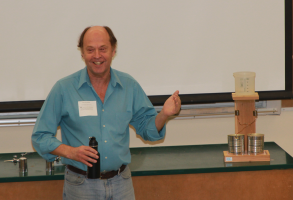Bree Barnett Dreyfuss, Amador Valley High School Bree shared examples of story telling in her class room including: Using comics & pictures Using video clips Interpreting graphs & drawings Anecdotes and stories of scientists and discoveries Bree worked with a colleague to develop curriculum surrounding the book The Pluto Files by Neil deGrasse Tyson. She shared curriculum materials from her unit that are available on her website here.
Category: University support
Tom showed us a conducting experiment (picture to come) with two cans and a two copper wires that do not touch and attach to a coup of water. After the cup of water is filled a small neon bulb that that is connected to one of the two copper wires can discharge repeatedly. Tom’s best guess as to why it flashes is that one of the metal cans becomes randomly charged, say negatively, and that negative charge travels up the conducting materials to the water and repels electrons through the other wire to the other side that builds up potential.
Dan Burns, Los Gatos High School
Join us at Sierra College in Rocklin, CA (just 20 miles NE of Sacramento) for the fall conference of the Northern California/Nevada Section of the American Association of Physics Teachers. Starting with a social and planetarium and museum tour, followed by a full day of physics education speakers and workshops on Saturday.

Logistics
Lee Trampleasure, Carondelet High School – deriving the kinematics equation experimentally
Students use TI calculators to derive the kinematics equations. Students graph a linear position-time graph for different constant velocity cars. Student graph the data by hand and then uses linear regression to calculate the slope which will vary from student to student as their best fit lines differ. Students then plot a constant acceleration car and graph that data in their calculators. By taking various tangent lines students create a separate graph of the velocity-time for the car. Using the equation supplied by the calculator they begin to see the relationship between their y-intercept on the y=ax+b equation from the velocity-time graph matches the b in their equation for the position to time graph (x=at^2+bt+c).
David Talcott, Carlmont High School (c/o Bree) – Planck’s constant apparatus

